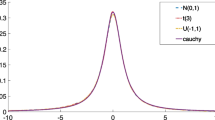Abstract
Consideration was given to the estimation of the unknown parameters of a stable infinite-dimensional autoregressive model from the observations of a random time series. The class of such models includes an autoregressive moving-average equation with a stable moving-average part. A modified procedure of the least-squares method was used to identify the unknown parameters. For the infinite-dimensional case, the estimates of the least-squares method were proved to be strong consistent. In addition, presented was a fact on convergence of the semimartingales that is of independent interest.
Similar content being viewed by others
REFERENCES
Ljung, L., Analysis of Recursive Stochastic Algorithms, IEEE Trans. Automat. Control, 1977, vol. AC-22, pp. 551–575.
Barabanov, A.E., On Strong Convergence of the Least Squares method, Avtom. Telemekh., 1983, no. 10, pp. 119–127.
Lai, T.L. and Wei, C.Z., Asymptotic Properties of Projections with Application to Stochastic Regression Problems, J. Multivariate Anal., 1982, no. 12, pp. 346–370.
Mari, J., Dahlen, A., and Lindquist, A., A Covariance Extension Approach to Identification of Time Series, Automatica, 2000, vol. 36, no. 3, pp. 379–398.
Durbin, J., The Fitting of Time-series Models, Rev. Inst. Int. Stat., 1959, pp. 223–243.
Whittle, P., Estimation and Information in Stationary Time Series, Ark. Mat. Astr. Fys., 1953, vol. 2, pp. 423–434.
Wold, H., A Study in the Analysis of Stationary Time Series, Uppsala: Almqvist and Wiksell, 1938.
Marple, S.L., Digital Spectral Analysis with Applications, New Jersey: Prentice Hall, 1987.
Akaike, H., A New Look at the Statistical Model Identification, IEEE Trans. Automat. Control., 1974, vol. AC-19, pp. 716–723.
Gerencser, L., AR(∞) Estimation and Non-parametric Stochastic Complexity, IEEE Trans. Inf. Theory, 1992, vol. 38, no. 6, pp. 1768–1778.
Goldenshluger, A. and Zeevi, A., Non-asymptotic Bounds for Autoregressive Time-series Modeling, Ann. Statist., 2001, vol. 29, pp. 417–444.
Hannan, E.J. and Deistler, M., The Statistical Theory of Linear Systems, New York: Wiley, 1988.
Shibata, R., Asymptotic Efficient Selection of the Order of the Model for Estimating Parameters of a Linear Process, Ann. Statist., 1980, vol. 8, no. 1, pp. 147–164.
Gel’, Yu. R. and Fomin, V.N. Identification of the Linear Model of a Stationary Process from Its Realization, Vestn. S.-Peterburg. Univ., 1998, vol. 2, no. 8, pp. 24–31.
Gel, Yu. R. and Barabanov, A.E., Convergence Analysis of the Least-squares Estimates for Infinite AR Models, Proc. 15th IFAC World Congress, Barcelona, Spain, 2002.
Said, E.S. and Dickey, D.A., Testing for Unit Roots in Autoregressive—Moving Average Models of Unknown Order, Biometrica, 1984, vol. 71, no. 3, pp. 599–607
Green, M., Linear Robust Control, New Jersey: Prentice Hall, 1995.
Wahlberg, B., Estimation of Autoregressive Moving-average Models via High-order Autoregressive Approximations, J. Time Series Analys., 1989, no. 10, pp. 283–299.
Gel, Yu. R. and Fomin, V.N., Identification of an Unstable ARMA Equation, Math. Probl. Eng., 2001, no. 7, pp. 97–112.
Fomin, V.N., Matematicheskaya teoriya obuchaemykh opoznayushchikh sistem (Mathematical Theory of Trainable Recongnition Systems), Leningrad: Leningrad. Gos. Univ., 1976.
Dufflo, M., Random Iterative Models, Berlin: Springer, 1997.
Robbins, H., Siegmund, D., A Convergence Theorem for Nonnegative Almost Supermartingales and Some Applications, Proc. Sympos. Optimiz. Methods in Statist, New York: Academic Press, 1971.
Ljung, L., System Identification—Theory for the User, New Jersey: Prentice Hall, 1999.
Author information
Authors and Affiliations
Additional information
This work was supported in part by the Russian Foundation for Basic Research, projects nos. 01-01-00306, 04-01-00084, and project no. 00-15-96-028 for the Russian Scientific Schools.
Translated from Avtomatika i Telemekhanika, No. 1, 2005, pp. 100–117.
Original Russian Text Copyright © 2005 by Barabanov, Gel’.
Rights and permissions
About this article
Cite this article
Barabanov, A.E., Gel’, Y.R. Convergence of the least-squares method with a polynomial regularizer for the infinite-dimensional autoregression equation. Autom Remote Control 66, 92–107 (2005). https://doi.org/10.1007/s10513-005-0009-1
Received:
Issue Date:
DOI: https://doi.org/10.1007/s10513-005-0009-1




